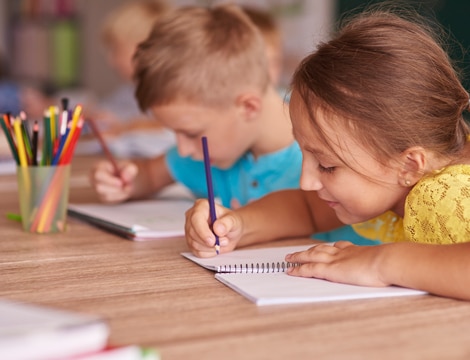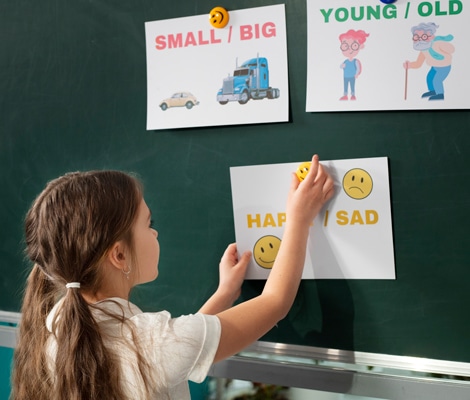Many expats with children move to Canada, drawn by its education system, which many regard as one of the best in the world, and knowing their offspring will receive a top-notch education.
In the following guide, we give you a comprehensive overview of education in Canada. You’ll find out about the structure of the school system and the provincial guidance, and we provide an introduction to private schools.

Brief Look at Education in Canada
The education system in Canada, a mosaic of intricate layers, caters to a diverse population. It’s characterized by a deep commitment to inclusivity, offering formal education starting from kindergarten programs to tertiary levels, with a keen focus on accommodating students from various backgrounds, including Canadian citizens, immigrant families, and foreign students.

Secondary school students in Canada have access to a variety of academic courses, vocational education, and special education classes, preparing them for a diverse range of futures. Upon completion of their secondary school studies, graduates receive a high school diploma, a credential that opens doors to higher education or vocational opportunities. Canadian high schools, spanning across different school districts, provide a comprehensive education that includes essential skills like financial literacy and an understanding of Canadian history, ensuring the development of well-rounded individuals.
For families, particularly those from low-income backgrounds or with special needs, support services are an integral part of the education system. Special programs and resources are provided, including distance education and online learning options, to ensure no student is left behind. This inclusive approach extends to indigenous knowledge, with many provinces incorporating native studies into their provincial curriculum, fostering an environment of understanding and respect for Canada’s rich cultural heritage.

The public education system, funded by the government and guided by principles enshrined in the Canadian Charter, is committed to serving the local community. From the tender age of four in kindergarten programs to tertiary level graduates, the system equips individuals with not just academic credentials but also a sense of well-being and preparedness for life’s challenges.
Teachers’ unions and the Ontario Ministry, along with other provincial bodies, play a crucial role in maintaining the high levels of educator quality and student performance. In recent years, there has been a special emphasis on the well-being and mental health of students, with schools working closely with community members to create a supportive learning environment.
Canada’s education system is a dynamic, multi-faceted entity, continually evolving to meet the needs of its students. It upholds high academic standards while nurturing the unique talents and backgrounds of each learner, thus contributing significantly to the nation’s reputation as a leader in global education.
The Quality of Education in Canada
Canada’s education system ranks fourth globally and many consider it as one of the best school systems in the world. Although each of Canada’s provinces and territories runs and oversees its own education system, there are government rules and standards that departments must adhere to across the country to ensure high-quality public education.
Canada’s curriculum is also well-known for being comprehensive and flexible. There is a focus on the student’s individual needs and talents rather than just grades. This sets it apart from other excellent education systems, which is often more concerned with league tables.
For example, Canada sees sports and the arts as important components of the curriculum. Physical education promotes healthy lifestyles and physical fitness, while arts education fosters creativity and cultural appreciation.
These subjects contribute to the holistic growth of students and reflect Canada’s commitment to a balanced and comprehensive education. However, specific requirements and the degree of emphasis on these subjects may vary among provinces and territories.
The Structure of the Canadian Education System
The Canadian school system includes four primary stages: preschool or pre-kindergarten, primary and secondary education (referred to as K-12), and post-secondary education. While there may be slight variations among provinces, each of these stages has unique characteristics.
In the section below, we’ll give you an overview of all sections and what you can expect from each stage. Feeling confident about the Canadian educational system and Canadian schools will put your mind at ease when moving to Canada with your children.
Pre-elementary
Canada’s high-quality education starts from pre-elementary school. Often also referred to as kindergarten or kindergarten classes, it represents the initial phase of Canadian education, catering to children aged four to five prior to their entry into elementary or primary school.
In New Brunswick and Nova Scotia, attendance is compulsory, whereas in other regions, it remains a voluntary choice.
In Canadian kindergarten, children embark on a crucial early learning journey, focusing on a holistic development approach. They acquire foundational skills in literacy, numeracy, and social interaction. Language development takes center stage as students begin reading and writing basics.
Math concepts are introduced through hands-on activities, fostering problem-solving skills. Artistic expression and creativity flourish with arts and crafts projects. Physical education promotes gross motor skills and health awareness.
Moreover, kindergarten nurtures social skills, encouraging cooperation, communication, and empathy. Field trips, storytelling, and play-based learning enrich these experiences, fostering a lifelong love for education and a solid foundation for their academic journey ahead.
Primary
Public primary school in Canada is a cornerstone of the nation’s commitment to providing quality, accessible education for all children. Governed at the provincial and territorial levels, the Canadian primary school is characterized by its inclusivity, diversity, and comprehensive curriculum.
Children go to primary school aged six or seven and stay there for six years, depending on the province or territory. The curriculum focuses on core subjects such as mathematics, modern foreign languages, science, and social studies. Bilingualism is of high value, with an emphasis on English and French.
Canadian primary schools prioritize fostering critical thinking, problem-solving skills, and digital literacy. They promote a positive and inclusive learning environment that celebrates diversity and equality. Highly qualified teachers are dedicated to nurturing young minds and creating a strong educational foundation and extracurricular activities, including sports, music, and arts programs, which enhance students’ overall development.
Secondary
Secondary school, or high school education, is a crucial stage in a student’s academic journey, typically spanning grades nine to twelve. Known for its high-quality and inclusive approach, the Canadian secondary education system provides a well-rounded education that prepares students for both higher education and the workforce.
One of the defining features of a Canadian high school is its emphasis on diversity and inclusivity. Canada’s multicultural society reflect in its schools, where students from various cultural backgrounds come together, fostering a rich learning environment. This multiculturalism also reflects in the curriculum, which often includes courses that celebrate Canada’s cultural mosaic.
The high school curriculum in Canadian schools typically includes a core set of subjects such as mathematics, science, modern foreign languages, and social studies, which are compulsory for all students.
In addition to these core subjects, students have the opportunity to choose optional courses that align with their career aspirations. These range from the arts and humanities to technical and vocational subjects.
Moreover, Canadian secondary schools prioritize student engagement and critical thinking. Students are encouraged to participate actively in class discussions, extracurricular activities, and community service. This approach not only enhances their academic abilities but also nurtures their personal growth and leadership skills.
Post-secondary education
College and university in Canada are highly regarded for their quality, accessibility, and diversity. They encompass a wide range of options, including universities, colleges, technical institutes, and vocational schools, offering numerous opportunities for students to pursue their academic and career goals.
Canadian universities
Canada is home to many world-class universities renowned for their research and academic excellence. Institutions like the University of Toronto, McGill University, and the University of British Columbia consistently rank among the top globally. Canadian students can choose from undergraduate (Bachelor’s degree), graduate (Master’s degree), and doctoral programs (PhD) across various fields of study.
What’s more, Canadian universities are hubs for cutting-edge research, offering students the chance to participate in groundbreaking projects and gain valuable research experience.
Colleges
Career colleges, or community colleges, in Canada provide practical, hands-on education and training in fields such as healthcare, technology, business, and the arts. These institutions offer diploma and certificate programs that prepare students for specific careers in a shorter timeframe than traditional degree programs.
Technical and Vocational schools
Technical institutes and vocational schools focus on specialized training, equipping students with skills needed for specific trades or industries. These institutions play a vital role in addressing the demand for skilled workers in sectors like construction, automotive, and healthcare.
Other Types of Education in Canada
Canada also offers other types of schools to cater to all of its residents.
Private schools
Canada’s private education institutions offer alternative educational options to students and families seeking specialized learning experiences. These institutions operate independently of the public school system and often provide smaller class sizes, enhanced facilities, and unique curriculum offerings.
Private schools vary widely in focus, including religious, Montessori, arts, or STEM-based education. While tuition fees can be high, private institutions often emphasize personalized attention, extracurricular activities, and a strong sense of community.
Many of those private institutions in Canada have a reputation for academic excellence and may have a competitive admissions process. Through this excellence, they contribute to the diversity and choice within the Canadian education landscape.
Religious schools
Religious schools in Canada are educational institutions affiliated with specific faiths or denominations, providing students with a curriculum that integrates religious teachings and values into their education. These schools offer a faith-based learning environment, incorporating religious studies, moral guidance, and religious ceremonies or practices into the daily routine.
Parents who prioritize religious education often choose these schools to instill their faith and values in their children. In Canada, religious schools are diverse, representing various religions, including Christianity, Islam, Judaism, and others. They contribute to the cultural and religious diversity of Canadian education, offering students a unique blend of academic and spiritual development.
Age of Compulsory Education
Canada places a strong emphasis on ensuring that children receive a minimum level of education to support their development and future opportunities. In Canada, children have to attend school or be in some kind of education between the ages of six and eighteen.
Most provinces and territories require children to start attending school by the age of six or seven and continue until they reach 16, 17, or 18 years old. However, these age requirements can differ, so it’s essential to consult the education regulations specific to the province or territory in question.

Which provinces in Canada differ from the standard system?
Canadian education typically follows a similar structure across provinces and territories. However, there are some variations and unique features in certain regions:
- Quebec has a separate school system, primarily due to its French-language focus. The province’s public schools primarily use French as the language of instruction, with limited English-language options.
- Newfoundland and Labrador’s system includes denominational (religion-based) schools, which is a historical legacy. They receive public funding but maintain their religious affiliation.
- In the Nunavut and Northwest Territories, the system often includes more indigenous cultural content and programming, reflecting the local indigenous communities’ unique needs and traditions.
What language lessons are taught in Canada?
Lessons in Canada are primarily taught in English and French, reflecting the country’s official bilingual status. English-language instruction is predominant in most provinces and territories, while French-language instruction is prominent in Quebec and certain areas of other provinces, particularly in bilingual regions.
However, Canada is a multicultural nation, and many schools offer programs to support students whose first language is not English or French. In addition to English and French, some indigenous languages are also used in education, particularly in schools located in indigenous communities, as part of efforts to preserve and revitalize these important linguistic and cultural traditions.



Migrant Students
Migrant students in Canada represent a diverse group, including immigrants and refugees from various countries. Canadian schools prioritize inclusivity and offer support to help these students adapt to their new environment, learn the language, and integrate into the school system.
Programs such as English as a Second Language (ESL) and cultural sensitivity training aim to facilitate their transition, and Canada’s commitment to multiculturalism fosters a welcoming atmosphere for migrant students.
The Canada Citizenship by Investment program allows foreign entrepreneurs to sponsor their spouse and unmarried children. Citizenship in Canada provides access to quality education for different learning situations. Public schooling is free from primary to high school.
Equal Opportunities
Equal opportunities are the pillars of the school system across Canada. It strives to provide all students with equitable access to quality education, regardless of their background, socioeconomic status, or abilities. Special education programs, financial aid, and language support are available to ensure that every student has a chance to succeed.
Anti-discrimination policies and diversity initiatives promote a safe and inclusive learning environment. This commitment to equal opportunities helps nurture a diverse, skilled, and empowered workforce.

Is education in Canada free?
Canada’s public school system is not entirely free but is publicly funded through taxes, which significantly reduces the cost for Canadian citizens and permanent residents. Public elementary and secondary education until the 11th or 12th grade is provided at no direct cost to students.
However, after secondary education, tuition fees have to be paid for college and university. Tuition costs vary depending on the institution, program, and province. Scholarships, grants, and loans are available to help students with financial assistance, making education more accessible for many.
Fees for international students may be higher, so make sure you do some research and potentially apply for scholarships and grants to help with high tuition fees.
Public and private schools
As mentioned above, a Canadian private school can be a great alternative to public schools if parents want a more specialized education for their children. Those who have the financial resources may consider sending their children to a private school; however, both private and public schools offer quality education to all children.
Key Takeaways from Education in Canada
In summary, Canada’s education system is a testament to the nation’s commitment to inclusivity and high academic standards. Beginning with early childhood education in kindergarten programs and extending through primary, secondary, and post-secondary levels, Canadian schools foster a nurturing and diverse learning environment.
Secondary school graduates, equipped with a robust secondary school diploma, emerge well-prepared for further education or vocational pursuits. Catholic schools, independent schools, and public school districts, under the guidance of respective school boards, offer varied curricula, ensuring that all students, including those from low-income families, receive a comprehensive education.
With one of the highest global rankings, Canada’s education system, including middle schools and high schools, successfully integrates health care, academic, and socio-emotional aspects, paving the way for students to attend college or university. This holistic approach reflects in the graduates, who are well-rounded individuals ready to contribute meaningfully to society.
Frequently Asked Questions About Education in Canada
Is Canada good for education?
Yes, Canada is renowned for its high-quality education system, welcoming environment for international students and world-class institutions. It’s a popular destination for students seeking a top-notch education and cultural diversity.
Is Canada's education better than the US?
The quality of education in the US versus Canada depends on various factors, including individual preferences, institutions, and programs. Both countries offer excellent educational opportunities, and the choice between them should align with specific academic and career goals.
What is post-secondary education in Canada?
This refers to educational opportunities beyond high school, including colleges, technical institutes, and universities. It offers various diploma, certificate, degree, and applied degree programs, preparing students for careers and advanced studies in their chosen fields.
Where does Canada rank in education in the world?
It currently ranks fourth in the world and has consistently been among the top countries for education in various international assessments. It’s known for its quality, accessibility, and inclusivity, making it highly regarded globally.



